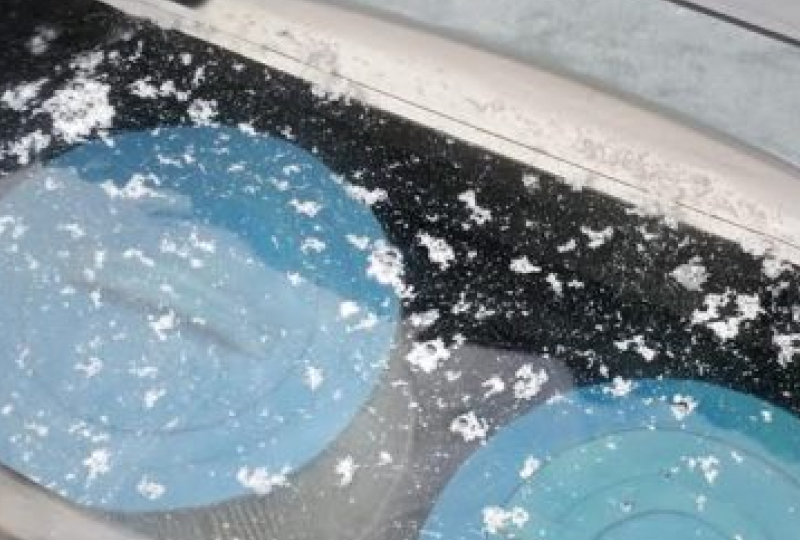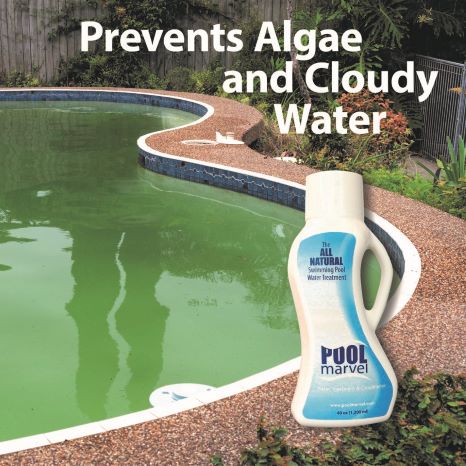
White Mold in the Pool
White water mold is a naturally occurring fungus typically found in pool areas with poor circulation. Although it’s not harmful to humans, it’s unsightly, can clog your pool equipment, and may create an unsafe environment for swimming. Because it’s difficult to eradicate, preventing it in the first place is critical.
Jump To Section:
What Is White Water Mold?
What Causes White Water Mold in Pool Water?
How to Prevent White Water Mold in Pools
How to Treat White Water Mold in Pools Using Chlorine
How to Treat White Water Mold in Pools Using Biguanide
What Is White Water Mold?
White water mold is naturally found in water in pool areas with low circulation, such as ladders, in the skimmer, and behind the return jets. If it’s found floating in your pool water, it’s likely present throughout your entire piping and filtration system. It could indicate a problem with your chlorine levels, too.
If shown pictures of white water mold in pools, you would see a white fungus that looks similar to shredded tissue paper or mucus. It is flaky looking and typically floats on the pool water’s surface, although it can also be submerged.
This type of mold is non-pathogenic and presents minimal danger to swimmers. The organisms die right after you leave the water and dry off. However, it’s commonly accompanied by pink slime, a type of bacteria that can cause numerous illnesses.
White water mold has a heavy, protective coating that makes it highly resilient to halogen-based (chlorine and bromine) and non-halogen sanitizers and germicides. These unpleasant fungi will deplete a pool’s oxidizer levels, making it almost impossible to maintain a proper sanitizer level. It’s more likely to develop in indoor pools, where UV rays cannot kill it.
What Causes White Water Mold In Pool Water?
White water mold can form when there’s a chemical imbalance, inadequate water circulation, or poor pool maintenance. Recontamination of white mold in pools is common – even a tiny amount of white water mold can quickly escalate into a full-sized mold colony.

How To Prevent White Water Mold In Pools
To easily prevent the formation of white water mold in pool water, follow the steps below:
1. Clean the Pool, Equipment, Accessories, and Toys
Keep your pool as clean as possible. Every day, skim the surface of your pool and empty your skimmer baskets. Use a proper brush to clean your pool walls and floors every week. Vacuum your floors using a powerful automatic cleaner.
Thoroughly clean any pool brushes, hoses, and vacuums after each use. Clean any other accessories, maintenance equipment, or pool toys to prevent any future contamination.
2. Follow a Regular Pool Maintenance Schedule
Keep your pool chemicals balanced, run your filtration system regularly, and brush pool surfaces often. Maintaining the proper level of sanitizer is critical. Recheck the water balance after heavy rain or substantial amounts of new water.
3. Allow For UV Exposure
Allow your pool and accessories to be routinely exposed to the sun’s UV rays, a natural oxidizer that helps destroy white water mold. If you typically use a pool cover, remove it for a few hours every week to allow the water to be exposed to the sun.
4. Clean and Operate the Pool Filter
Keep a close eye on your pool’s pressure gauge, and regularly clean your pool filter with chemicals. Backwash sand and DE filters whenever necessary.
Run your pool filter for at least 12 hours daily to prevent dead spots from forming in the pool.
How To Treat White Water Mold In Pools Using Chlorine
Treating white mold in pool water can be challenging but not impossible. However, treatment must be quick and thorough. Follow the steps below to eliminate a white water mold issue in chlorinated pool water:
1. Test Your Filter Pump
Ensure your filter pump is operating normally before starting the treatment process.
2. Clean the Filter
If mold is found in your pool, there’s likely mold in your filter, too. If that’s the case, cleaning your pool water won’t be effective.
Start by backwashing your sand or DE filter, or expose your cartridge filter to 30 ppm of chlorine for a continuous 72 hours.
3. Test and Balance Your Water
Test and balance your pool chemicals, paying particular attention to your pH so that the next step (completing a shock treatment) will work.
4. Super Chlorinate the Pool
The cell walls in white water mold help protect it from pool sanitizers. As a result, very high levels of chlorine are necessary to kill the mold.
Shock the pool using chlorine shock and apply the treatment at dusk or night unless you have an indoor pool that receives no sunlight. Operate your pump for at least 72 hours following the shock treatment.
Maintain a chlorine level of 30 ppm for 72 hours. Chlorine gets used up quickly when dealing with white mold, so continuously test your chlorine level.
5. Skim and Brush the Pool
Skim as much of the mold as possible from the surface. Thoroughly brush all of your pool’s surfaces using an appropriate brush – soft bristles for vinyl/tile finishes or steel bristles for plaster/concrete. Reach into all of the dead spots with your brush.
6. Operate the Pool Pump
Run the pool pump for at least eight hours to filter everything you brushed up.
7. Brush and Vacuum the Pool
Thoroughly brush all of your pool’s surfaces again. Manually vacuum your pool.
If the water needs to be topped up, use a garden hose. However, be sure to run it for a few minutes before adding it to your pool. This helps ensure any potential mold from the hose does not transfer into your pool.
8. Clean the Filter Again
Clean your filter again using a filter cleaner for your sand/DE filter or a chemical soak for your cartridge.
9. Test and Balance Your Water
Test and balance your pool chemicals.
10. Wait
Watch to see if any mold appears. If it does, you’ll need to repeat the entire process. If it doesn’t, maintain the cleanliness of your pool water to help avoid a recurring mold issue.
How To Treat White Water Mold In Pools Using Biguanide
To treat white water mold in pool water that uses biguanide, you can follow the same process as treating white water mold in pools using chlorine, with the following exceptions:
- Use a triple or quadruple dose of oxidizer rather than pool shock.
- One week after finishing the cleaning process, add four ounces of biguanide algaecide for every 10,000 gallons of pool water. This can also be added weekly for white water mold prevention.

